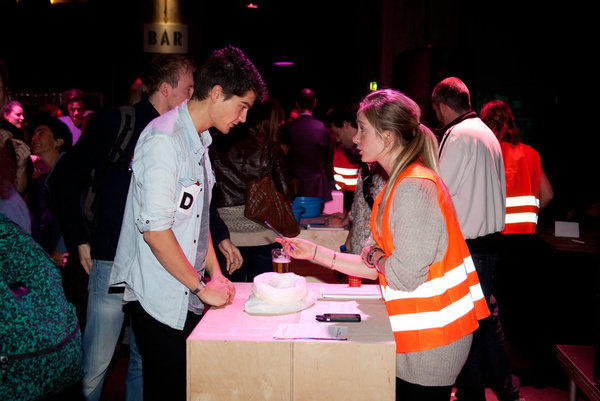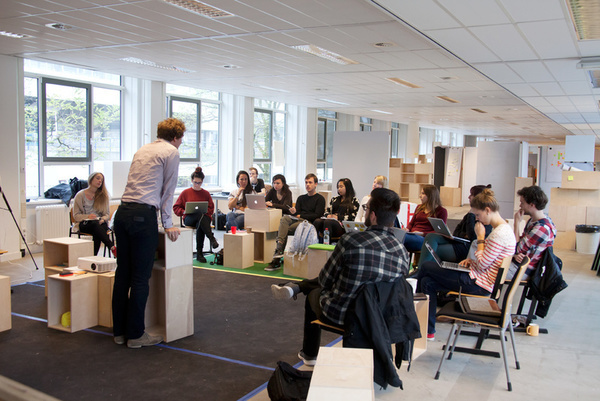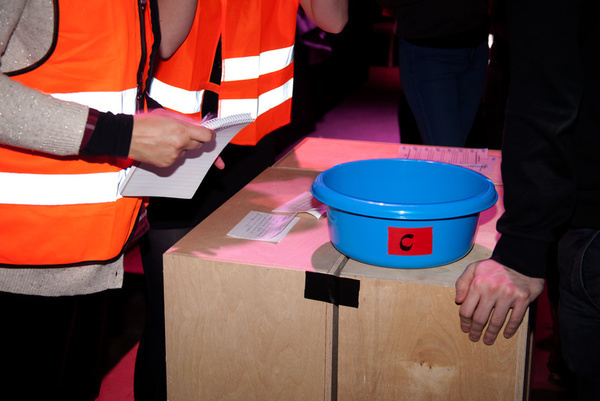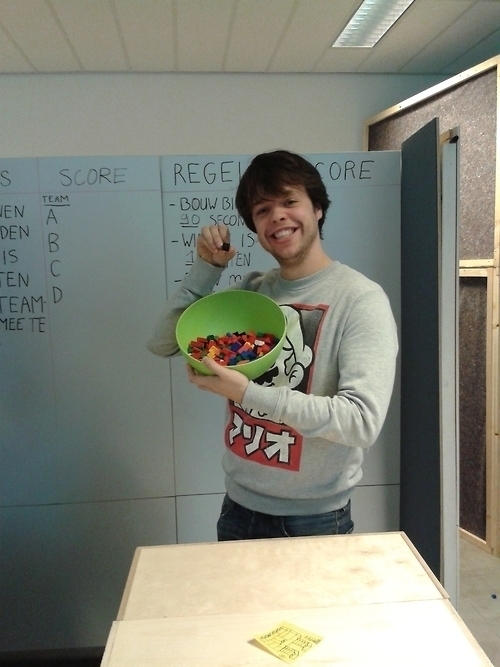Gamifying the Circular Sharing and Civic Economy
Contents
- 1 Pervasive games
- 2 Overall experience
- 3 References to the sub-projects
- 3.1 A Proposal for gamifying the old economy, from economic principles to game rules
- 3.2 A Proposal for gamifying the circular economy, from economic principles to game rules
- 3.3 A Proposal for gamifying the civic economy, from economic principles to game rules
- 3.4 A proposal for gamifying the sharing economy, from economic principles to game rules
- 3.5 Expert opinion during the preparation of the project
- 3.6 Lessons to be learned
- 3.7 A critical note
- 4 Links
The wikipage input value is empty (e.g. SomeProperty::, [[]]) and therefore it cannot be used as a name or as part of a query condition.
Pervasive games
We researched, tested and/or commented on new business models by designing and implementing gamified interventions during the Redesigning Business Symposium on 20 November 2014. During this evening, these interventions allowed the public to experience what these new business models mean, here and now.
We analysed various business models and distilled a number of 'game rules' which we will introduce during the symposium. Visitors will experience the consequences of the 'game rules' of current and future business models by participating in a pervasive game (a combination of reality and game). In doing so, they will gain insights into the various business models and will be able to compare them. We will thus invite them to enter an interesting discussion. A side effect of distilling game rules is that the games transmit an inherently political view.
This method of using games neatly corresponds with the basic rules of Gamification in education by incorporating the slogan "Play, don't tell". With careful design, players will experience and be confronted by the consequences of their own actions. While this short experience will not explain the more detailed questions surrounding complex topics, it will aid the participants in the overall experience of listening to the keynote speakers and presentations, linking their game experience to the more difficult topics.
Overall experience
Visitors to the Symposium were given different stickers at the entrance. Each sticker assigned the visitor to a fictitious company. Players participate individually, but score points for their companies, working together with strangers towards a common goal. They were asked to build products (Lego figures) using four different economic strategies at the four different stands with a time limit of one minute. Success meant scoring for the whole company. Different games have different mechanics resembling the four different types of economies. Which type of economy was portrayed wasn't conveyed by the information flyer or by the stand itself. The idea was that the stallholder and the contestant would reflect on the nature of the economy portrayed.
References to the sub-projects
This project is divided among four different sub-projects, of which three resemble the new economies and one resembles the old economy:
A Proposal for gamifying the old economy, from economic principles to game rules
Assumptions
We live in a world of limited resources, but not of limited needs. This principle is called scarcity, and is one of the basic principles of the classic or "old" economy. Scarcity describes the relationship between supply and demand in an economy with limited resources.
Translation of assumptions to design principles
The old economy uses the cradle to grave principle, in which resources are used only once. In this principle, where resources are used only once, you need to use your resources thoughtfully in order to make the most of them.
Game proposal
In the Redesigning Business Week's Gamification Masterclass, we tried to translate this principle of scarcity into a pervasive game. Each team has a limited pool of resources with which they build different products to gain points. A team can choose to build an easy product, but in doing so it uses a lot of resources. The other option is to build a difficult product which may need fewer resources, but which is less likely to succeed because of the given time limit of 60 seconds. The resources are limited for each team, so choose wisely, because if you fail to make your product within the time allocation, your resources will be spent as well.
Storytelling
You could translate this principle into the idea of designing for the dump. The easy products are simple to produce but have a lot of waste material once finished, while the difficult products – for instance, products made from durable resources – have less waste. Furthermore, eliminating the used resources from the game as waste, gives this game a definite end, which reflects the linear process of the "old" economy.
A Proposal for gamifying the circular economy, from economic principles to game rules
Assumptions
The circular economy is an economic design based on reduce, re-use, recycle. Energy must come from renewable sources. One of the problems with the circular economy is to retrieve the required high quality resources from waste. Development should therefore focus on pre-sorting instead of post-sorting strategies.
Translation of assumptions to design principles
The design should reflect the necessity within the circular economy to rethink design so that high valued resources can be easily retrieved. Furthermore, the use of lower quality materials will generally result in a lower price. Rethinking design can be done by literally letting the players search through a pile of resources for the right resource, while still enabling them to achieve their goal with lower quality resources (albeit at a lower price).
Game proposal
The circular economy game is a game where players make a product from waste. They need to filter the waste in order to make a perfect one colour product. If they can't find the right colour resource, they can opt to use another colour, but this results in lower profit.
Storytelling
The bowl represents the pile of waste through which players search (i.e. other coloured blocks). The need for high-end recycled products is represented by searching for just one type of resource among several resources of lower quality (i.e. other coloured blocks).
A Proposal for gamifying the civic economy, from economic principles to game rules
Assumptions
The civic economy is an economic design based on cooperation and local production, local entrepreneurs and local resources.
Translation of assumptions to design principles
Cooperation among local entrepreneurs means there is a need to have an additional party accounting for resources (as opposed to the other economies apart from the sharing economy). Ideally, this person should be located nearby (since this is about 'local' entrepreneurs working together), but he/she should be distinct from the other game stands.
Game proposal
In the civic economy game, you make a product using local resources, but you only have either yellow or black resources. You have to negotiate with a local company to trade your excess resources. Together you'll be able to finish both your products.
In practice it means that you start working on a product at one stand, which only has resource A –grain, for example. But you also need resource B – coal, for example – to make your product. You need to go to the other stand with resource A (a product you have too much of) and trade it there for resource B (which are leftovers for that stand). You can start making your product at both stands to start with, but eventually you'll need the leftover resource of the other stand to finish your product.
Storytelling
Trading the product implies trading excess resources which other local companies can use. This represents the extra products and waste which companies would normally dispose of, but which can be re-used by companies in community-based collaborations that characterise this type of economy.
A proposal for gamifying the sharing economy, from economic principles to game rules
Assumptions
These essential principles, in my opinion, are 'trust' and 'shared benefit'. Creating together result in something that is in fact larger than the sum of its components. However, both contributing businesses will have to trust that the other considers this shared benefit equally important. If not, the system will simply fail.
Translation of assumptions to design principles
The assumption above displays a game concept in terms of victory and failure. In this game proposal, playing together is essential to even have a chance of winning. Not being able to play together – or trust each other for that matter – means failure for both participants. Playing together, however, should also have an incentive on top of winning to underline the urgency of the sharing economy.
Translating these conditions to the concept of the entire pervasive game at the symposium, and using four small building games using LEGO bricks to visualise each of the economies named above, I came up with the following proposal.
Game proposal
In this game, as the player approaches the table, he or she is instructed to find another player as this game can only be played in pairs. While most of the other mini games have one set of resources, this one has two sets of resources: one for each player. Both players have a bowl with one type of resource. In order to make the shape shown on a picture by the game master within 60 seconds, they have to share their resources AND think about how they are going to build the shape together. Winning means that each competing team gets one point, meaning that playing with someone from a different team generates a better joint result than playing with a member of the same team. I hope that this will introduce the players to the concept of sharing to derive better joint benefits.
Storytelling
Imagine that both players are businessmen and the teams are different companies, each of which makes a product from different resources. However, the companies do not own all the resources. Consequently, the product can only be made by working together and 'sharing' resources. Joint benefit is key here. Of course, both businessmen who work together 'may' be from the same company, but this will not bring the team more benefits than if they were from different companies. Working together with a different company means benefits for both cooperating companies: 1+1=3!
Expert opinion during the preparation of the project
Frederic Sanders from DRIFT was invited to give feedback on the first demo of the games. He is an expert in the field of 'entrepreneurship in transition' and the perfect person to see if the translation of economic principles to design principles was effective. In a quick recap he stated that this kind of game would be perfect to help people experience the core aspects of these new economies. They would not be used as stand-alone games but as meaningful add-ons to lectures. The main strength is that these games could - separately or as a series - help internalise this new information. The main idea: play the game and subconsciously experience the core economic principle. After that listen to the lecture and connect the new knowledge to prior experience.
Lessons to be learned
In this last section, we will reflect on three different questions:
- How can pervasive games help visitors to a conference understand the complicated economic models discussed?
- What is the influence of the pervasive method as opposed to a classic game method?
- Are the gamified depictions of the economic principles politically neutral?
The educational lesson
As mentioned by Frederic Sanders during his visit, while these games cannot convey the complexity of these economic systems, they certainly can function as handy reminders of the basic differences between the different economies for visitors to conferences such as the Beyond Social. They may be particularly useful in multi-disciplinary conferences where visitors from different domains shed light on cooperative fields of study, and where there may well be visitors who only have a vague idea of 'the sharing economy' or 'the civic economy'. These games then function as a quick-start to understand the more difficult information shared by keynote speakers.
The pervasive lesson
In game design theory, reference is often made to the so-called 'Magic Circle'. The magic circle is a distinct place and time where other social rules (i.e. the game rules) hold instead of a number of standard social rules. As an example, the game of chess is played on an 8x8 white and black board (place) on which we try to replace the 'King' of the opponent with our own King while abiding by certain rules (i.e. not just taking away the Queen and placing my Queen there, since this is against these new social rules) while the game lasts (time). A pervasive game tries to blur these social, spatial and temporal boundaries and make them more penetrable/porous, blurring the distinction between the game world and the real world. The following events at the conference characterised these more penetrable boundaries between the game and real worlds:
- After the game players were asked to explain what they experienced and how they could relate their experiences to one of the new types of economies. This made them actively reflect on the game mechanisms and on the distilled economic rules for the different types of economies. If the storytelling was effective, most of the participants were able to distill the type of economy that was portrayed.
- While the game was played, and especially when players were playing the sharing economy game, they were forced to find another player to cooperate with. Bystanders were often asked to join the game in progress, making them at least aware of the games played at the conference and their relevance to the conference. The line between bystander and participant was thereby blurred, which effectively increased the number of participants.
- Even when players didn't participate, they probably talked to players who had stickers containing their fictitious companies, thereby being indirectly involved in the matter discussed by the game.
The pervasive game fuelled the discussion on economic systems and by its very permeable nature was able to attract new players.
A critical note
It should be noted that the design choices outlined above portray a distinct political view on the different types of economies and do so necessarily. By distilling the 'essential economic rules', we must avoid making a caricature of the economic theory we wish to portray. Naturally, there is a thin line between a model being too complex to fit in an economic game, and overly simple model that renders it a caricature. But even if we succeed in staying on the thin line between the overly complex model and the caricature, we still decide which elements we believe define each type of economy and in so doing incorporate a view on the nature of these economics in our game design.
The choice of elements will therefore betray a particular view, be it Marxist, ecologist, (neo)-capitalist or Keynesian. To portray the old economy from a Cradle to Grave principle not only distinguishes it from the Cradle-to-Cradle principle of the circular economy, but it also neglects the need of the classical economy for efficient production processes in order to be competitive and therefore emphasises expensive and limited resources. These needs are clearly expressed in some branches such as the automotive industry, where the 2014 Mazda commercial has one of Mazda's leading designers explain that they were proud to have further reduced the car's weight by another half kilo by using innovative design. Therefore, pervasive games aren't just a perfect translation of the economic principles. They are both a model and a medium for a view on the different economies.
This Master Class was developed within the Gamification department (Social Practice @ WdKA) Tutors: Bruno Setola, Remko van der Pluijm and Arjen de Jong.Links
CONTRIBUTE
Feel free to contribute to Beyond Social.













